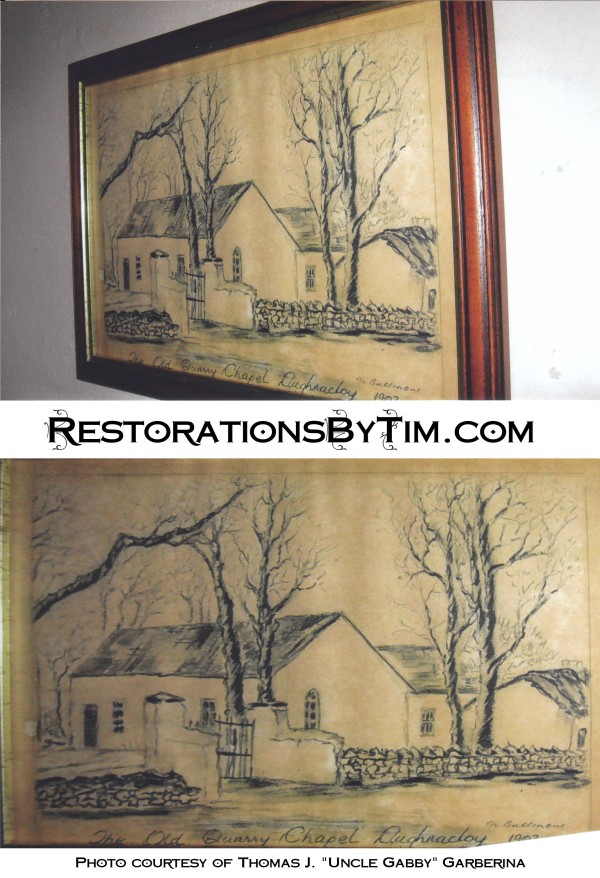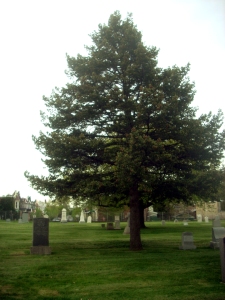
I’m continuing McShane research this week for my great-uncle, Gabby. He had asked me a few weeks ago to build him a CD of McShane family history in anticipation of his Grand-daughter’s wedding. I went to the Philadelphia Archdiocese Historical Research Center about a week and a half ago to learn more about Fr. Francis J. McShane, and Augustinian priest and one-time president of Villanova University. I copied some articles of interest there, including a published history of one parish where Fr. McShane was pastor, and I have spent the past several days compiling these articles into easily readable PDF files. I’ve probably spent more time on this than I should have, but hey. I’m a data miner. I’m a family history completist. If Fr. McShane’s name is on it, I want it for this collection.
A couple years ago, my Aunt Eileen and Uncle Gabby sent to me a set of photographs from their trip to Ireland, where they walked in the footsteps of their many Irish ancestors. One of their stops was Aughnacloy, County Tyrone, Northern Ireland, the hometown of the McShane branch of my family. My great aunt and uncle visited the location of the chapel where Fr. McShane was baptized. Although I have not fully confirmed that Fr. McShane’s siblings were all baptized at the chapel, I have chosen nonetheless to represent Fr. McShane’s older brother, my direct ancestor, Patrick, with this image of that chapel where he was potentially baptized.
Aunt Eileen and Uncle Gabby wrote for me what they had learned about the chapel: It was situated on Old Chapel Road in Aughnacloy, and stood until 1902. When it was dismantled, stones from it were used to build a new, larger church in the town. My great aunt and uncle had told me the new church was difficult to build, due to opposition from the primarily protestant townspeople. The drawing above was made in 1902, just before the old chapel’s dismantling. The original location is now an open space. My uncle photographed the above image at an angle, presumably to minimize the glare of the glass frame. I used GIMP to adjust the perspective of the photo. At left is an image of Aunt Eileen presenting the “new” chapel, built in 1902.
Patrick McShane was born in February of 1833, according to his entry in the 1900 census, and came to America in 1848, according to a recently-discovered naturalization document. The McShanes did not all come to America together. Fr. Francis came to America in 1855, apparently without other family members, and at the age of nine. I have not yet found Patrick’s ship’s passenger list, so I don’t know who all came with him. However, I did find a passenger list purporting to show that Patrick’s older siblings, Peter and Mary, came to America with their father , Terence, in early 1848, but I did not find either Patrick or their mother, Bridget, among them. They probably came at another time.
I know less about my direct ancestor, Patrick, than I so about his more renowned younger brother. I have in my notes that Patrick married his wife, Catherine Devine, on October 26, 1863, although the original document now appears ambiguous to me as to whether that might have been 1864. They were married by Rev. Carter at the Church of the Assumption on Spring Garden St. in Philadelphia. I don’t know if they were actually married in the church building. Many people of that time were married either at the rectory or at home. The church building still stands as of this writing, as it did in 1863, but it is no longer in use and frequently under threat of demolition. Apparently, the derelict building is a financial curse upon whoever owns it. The owners can’t tear it down because it’s certified historic. They can’t open it because it because of code issues. In its most recent debacle, a contractor now faces five years in jail for removing asbestos materials from the building without notifying all the proper environmental authorities and receiving the proper clearances. I love historic old buildings, especially those with a family connection, but maybe enough is enough.
Patrick and Catherine had 10 children in all, one of whom was stillborn. Four other children had died before 1900. Among the survivors was my great-great grandmother, Anne. On many early documents, including birth documents, Patrick McShane’s occupation is listed as Boatman. He shared this occupation with his older brother, Peter, who died in an 1862 drowning incident. Later on, census records listed Patrick’s occupation as dealer. A dealer in what, I did not know, until I found a birth certificate of one of his daughters, Jennie, which identified Patrick’s occupation as ‘Milk’. On the 1900 census, which would be Patrick’s last, his occupation is listed as Watchman. Occupation information is just as likely to be in Philadelphia City Directories. I’ll have to have a look more details
I often wonder about the family dynamic when one member is very prominent relative to the others. Patrick’s younger brother, Francis J. was a well-known priest and University president. Did Uncle Francis ever come out to the birthday parties and dance recitals of his nieces and nephews, or was he a busy, distant, far way uncle? Did big brother Patrick, the boatman, ever inspire young Francis, or rescue him peril, George Bailey style? I can only imagine.
Patrick McShane died of Catarrhal Gastritis at the age of 67 on the tenth of July, 1900. He was buried with most of his family, including his mother, at Old Cathedral Cemetery in West Philadelphia. The grave site is not marked.
Special thanks to Uncle Gabby and Aunt Eileen for inspiring this week’s line of research and for providing this week’s photographs.
UPDATE, 4/19/2014: I dug up this old document at the Philadelphia City Archives the other day. This is the duplicate marriage certificate of Michael and Bertha McGeehan. Michael was a nephew of Fr. Francis J. McShane, through Fr. McShane’s sister, Bridget (McShane) McGeehan. I sheds light on Fr. McShane’s relationship with the family. Although Fr. McShane happened not to officiate the marriage of his niece, my great-great-grandmother, Anne, he did officiate this 1898 marriage, which suggests to me that he was accessible to his family:









Leave a Reply